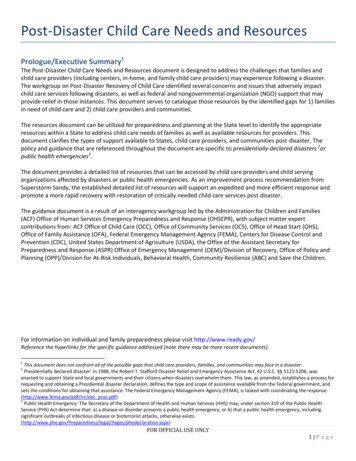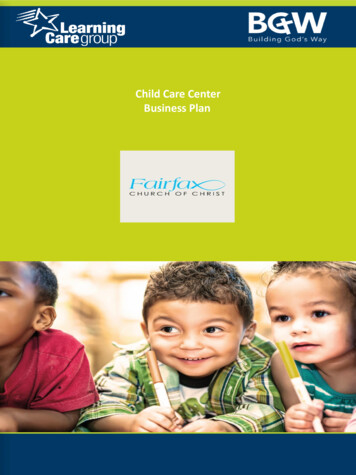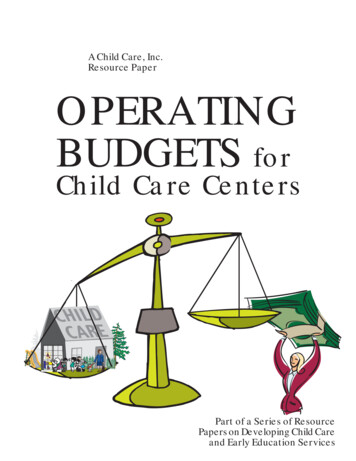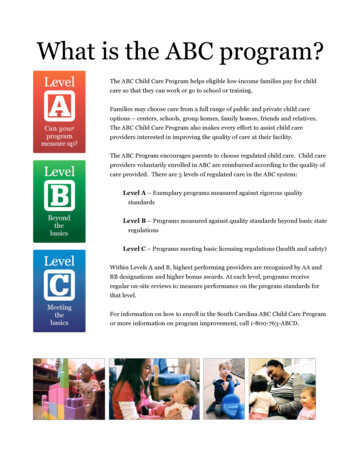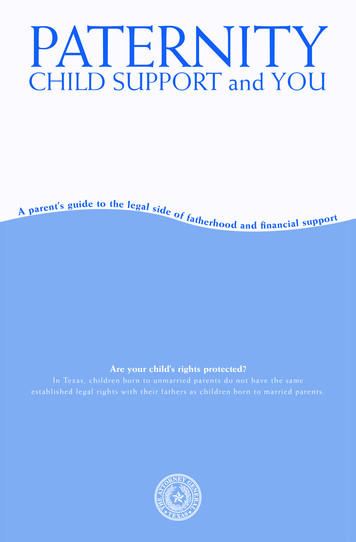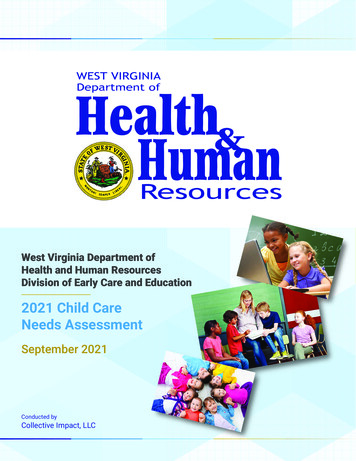
Transcription
West Virginia Department ofHealth and Human ResourcesDivision of Early Care and Education2021 Child CareNeeds AssessmentSeptember 2021Conducted byCollective Impact, LLC
ContentsIntroduction and Overview. 1Project Methodology. 1COVID-19 Pandemic. 3Child Care in West Virginia. 3American Rescue Plan. 6Analysis and Key Findings. 6Public Forum Overview. 9Child Care Provider Response Summaries. 9Stakeholder Response Summaries. 14Survey Overview. 16Child Care Provider Summary. 17COVID-19 Implications. 18Agency Interactions. 19American Rescue Plan. 20Additional Commentary. 20Parent/Guardian Summary. 21COVID-19 Implications. 23Agency Interactions. 25American Rescue Plan. 26Additional Commentary. 26Stakeholder Summary. 26COVID-19 Implications. 29Agency Interactions. 29American Rescue Plan. 30Conclusion. 31Resources. 32
Introduction and OverviewThe West Virginia Department of Health and Human Resources (DHHR) Division of EarlyCare and Education sought assistance from Collective Impact, LLC to conduct a StatewideChild Care Needs Assessment. The purpose of this report is to provide stakeholders anddecision-makers with greater insight into child care needs, opportunities, and capacitythroughout the state. Based on the perspectives of child care providers, parents/guardians,and stakeholders, the data in this assessment can support decisions for planning, policydevelopment and implementation, and resource leveraging and allocation.Outcomes: Provided a platform for child care providers, parents/guardians, and stakeholders toshare their perspectives of improvements, opportunities, and insights. Assessed the child care system in West Virginia through community assessmentmethods. Identified child care impacts and solutions in light of the COVID-19 pandemic crisis. Assessed child care enforcement and regulation value. Provided valuable feedback for DHHR, the legislature, and other key stakeholders fordecision-making and resource allocation. Gathered insight about priorities and ideas to inform strategic allocation ofAmerican Rescue Plan Pandemic Recovery Stabilization funds.Project MethodologyThe statewide child care needs assessment process included the following three (3) projectcomponents: (1) Plan, (2) Gather Primary Data, (3) Summarize and Analyze. Thiscomprehensive scope of services was executed by an experienced consulting team.1
(1) Plan April 1 – August 30Collective Impact and WV DHHR began their working relationship with planning sessionsand strategic discussions to ensure the successful execution of this assessment project.Meetings included: Initial Zoom virtual “orientation” session with project leadership Monthly Zoom virtual planning/check-in sessions Ongoing internal consulting team planning(2) Gather Primary Data July 11 – August 6It is crucial to gather input and perceptions using appropriate methods of primary research,communication, and engagement from people who are knowledgeable about child care andare directly impacted by decisions made. The target groups of community members wereselected as: child care providers, parents/guardians, and stakeholders. Data was collectedfrom these groups through two primary methods: survey and public forums.those issues and priorities most important to the assessment project.Survey July 11 – August 6The consulting team developed a child care survey to collect information about key issuesrelevant to the assessment project. The survey was to be completed by individuals identifiedby project leadership. The proposed survey was designed to generate ideas and identifythose issues and priorities most important to the assessment project.Public Forums July 20 – 28The Collective Impact consulting team facilitated public forums via Zoom with stakeholdersidentified and recruited by project leadership. There were separate forums for child careproviders, parents, and stakeholders. This inclusive process together individuals and/ororganizational representatives to share their experiences and ideas around specific topicsand issues. These forums allowed individuals to provide their input through facilitateddiscussion. The purpose of these was to generate creative ideas and identify issues, needs,and priorities most important to the assessment project.(3) Summarize and Analyze August 6 – August 30Based on the data collected from survey responses and public forum discussions, theCollective Impact team outlines key findings that will help strategic planning, policydevelopment and implementation, and resource leveraging and allocation throughout thestate. The team summarized the responses of the child care providers, parents/guardians,and stakeholders. The data was also analyzed to find any themes and patterns that couldbe useful for decision-making. This report ensures those that impact and are impacted bythe child care system in West Virginia have a platform to share their needs and innovations.2
COVID-19 PandemicAccording to the Centers for Disease Control and Prevention (CDC), COVID-19 is acontagious respiratory illness. COVID-19 has proven to spread more easily and remaincontagious longer than influenza. By March 11, 2020, the World Health Organization (WHO)declared COVID-19 a global pandemic. By March 17, 2020, all 50 US States had confirmedcases of the virus.By mid-March 2020, local, state, and federal public health officials recommended measuresto minimize a public health catastrophe through mass quarantine, physical distancing, andtemporary closing of shops, restaurants, and other venues where large groups would gather.This impacted child care facilities in temporary and even permanent shut downs.Child Care in West VirginiaIn response to COVID-19, on July 29, 2020, the House passed the Child Care is Essential Actin order to “stabilize the child care sector and support providers to reopen and operate. Italso would provide needed relief to protect child care workers, support working families, andimprove the safety of child care facilities.” It began to shift the perspective that child care isessential to the success of the nation’s economy.According to Child Care Center US, there are 518 licensed child care centers operating inWest Virginia. In West Virginia's Department of Health & Human Resources Division of EarlyCare and Education, the Child Care Program is dedicated to improving the affordability,accessibility, and quality of child care services. The Child Care Program also promotes safeenvironments that foster healthy physical, social, emotional, and intellectual growth ofchildren from birth to age 13, or up to age 18 if the child has special needs.According to the Center for American Progress, 64 percent of people in West Virginia live ina child care desert compared to 51 percent of people in America. In West Virginia, 78percent of rural families live in areas without enough licensed child care providers and 65percent of mothers of young children participate in the labor force. Beyond investing in thehealth development of children, child care supports working families, and in turn, businessand overall economic growth.3
According to WV DHHR, the various types of child care provided in West Virginia are centers,facilities, homes, Head Start, and Out of School Time Programs (OST). There are centers in48 counties, facilities in 30 counties, homes in 50 counties, Head Start programs in 32counties, and OST in 12 counties. With all types of child care, West Virginia has capacity for39,421 children. See Table 1 (below) for capacity by county.Table 8421221373394
The counties with capacity under 100 children are Braxton, Calhoun, Doddridge, Gilmore,Lincoln, Pendleton, Pleasants, Pocahontas, Roane, Ritchie, Wetzel, and Webster counties.The counties with the lowest capacity to provide child care are Calhoun, Wirt, Wetzel, andRitchie. In Table 2 (below), there is a breakdown of each type per county.Table ncolnLoganMarionMarshallMasonMcDowellMercerCenters lWirtWoodWyomingCenters 0400001042000000000001005
American Rescue PlanThe COVID-19 pandemic and the corresponding economic crisis threaten the health andeconomic wellbeing of American workers. The American Rescue Plan (ARP) was developedin response to these crises. The purpose of the American Rescue Plan is to deliverimmediate relief for American workers. The plan hopes to build a bridge to an equitableeconomic recovery and immediately reduce child poverty.According to the White House American Rescue Plan Report, this is “.the single biggestinvestment in child care since World War II.” The portion of the plan that directly impactschild care is the expansion of child care assistance to help hard-hit child care providerscover their costs, and increase tax credits to help cover the cost of childcare.West Virginia child care is receiving approximately 260 million in ARP funding to helpprovide support to improve the affordability, availability, and quality of child care services inWest Virginia and to provide stabilization of the child care market.The detailed overview from the White House can be found is and Key FindingsThis section summarizes the discussions and responses from the public forums andsurveys. Below are priorities, recommendations, and ideas based on the opinions ofparticipating child care providers, parents/guardians, and community stakeholders. It isimportant to hear and understand the perception of those closely involved and impacted byany changes that would be made.It is not disputed that COVID-19 created many strains on the child care system and, in somecases, caused facilities to permanently close. However, one of the more positiveimplications of the pandemic was that child care began to be valued and prioritized. Beyondthe Child Care is Essential Act, families and companies began to realize how essential thisservice was in their lives and economy.According to child care providers, these two aspects of funding are working well within thesystem: Funding is based on enrollment rather than attendance. This makes funding morepredictable and allows the center to make sustainable investments. Funding is based on a tier system as this incentivizes improvements.In the survey, providers did note needing some support to advance in the tiers:1. Assistant support for documentation (44.0%)2. Financial resources to hire qualified staff (39.9%)3. Professional development for staff (38.7%)6
ARP FundingOver the course of all of the discussions and responses, there were three priorities identifiedby the participants:1. Affordability and accessibility: There need to be expansion of child care servicesand decreased waiting lists especially in more rural areas. Child care costs arebarriers for families with most income levels. There is a need for more affordableservices or more subsidies.2. Provider development and staff retention: It is difficult to provide high quality careif there is constant turnover of staff. Increased wages, benefit packages, and childcare subsidies for staff could be an investment in retention as well as incentives forprofessional development opportunities and equipment improvements.3. Communication campaign: A community education campaign could teachcommunity members and lawmakers that child care is “more than just babysitting.”If people begin to understand the importance and value of early childhooddevelopment, there is more opportunity for funding, collaboration, and long-termimprovement.Beyond setting their priorities, participants provided actionable ideas and recommendationswithin each category about how to allocate funds from ARP.Accessibility and affordability Grants for expanding services, upgrading facilities and equipment, and educationalinnovation Identify the child care deserts by data mapping Make trail vans that pick-up children in rural areas to attend child care a priority. Theyare utilized in some areas but crucial to ensure families have access to care7
Provider development and staff retention Investment into staff to increase retention and maintain quality through living wages,bonuses, healthcare benefits, paid leave, professional development incentives, andfree child care Support a digital “just in time” substitute pool and other technology to streamlineprocesses Use evaluation tools to measure success for improvement and incentives Increase professional development opportunities to invest in future child careleadersIn order to provide the best care, participants wanted to focus on the holistic support offamilies through: Services for grandparents who are raising children and need respite or other formsof support Families dealing with SUD Staff a behavior specialist so someone is trauma-informed, understands AdverseChildhood Experiences (ACEs), and able to address social and emotionaldevelopment of childrenCommunity campaign Conduct an educational campaign that focuses on the importance of child care andits societal benefits Educate lawmakers and the general public on the importance and value of child careAdditional Ideas for Innovation1. Implement a “Maslow before Bloom” program that meets the basic needs ofchildren and families so that children can meaningfully participate in their learningenvironment. In this model, they can flourish more readily if they have theessentials for life, health, and preparedness.In support of meeting basic needs, parents participating in the survey ranked the followingneeds among their top priorities: mental health support, access to technology and reliableinternet, financial assistance to cover basic needs, and assistance with nutrition and food.Further, stakeholders participating in the survey ranked the following needs among their toppriorities: mental and emotional health support, food and nutrition support, assistance fordaily basic needs, assistance for utilities and housing expenses.8
2. Update the child care services payment structure for families.Public forum discussions had the following ideas: Initiate parents paying a small fee. Even if a subsidy program is in place, this willallow families to feel a sense of ownership and dignity while keeping the careaffordable. Implement a sliding fee scale as opposed to using a standard number that arbitrarilydisqualifies families for assistance.Public Forum OverviewPublic forms were hosted between July 20 - 28 to facilitate conversations betweenchild care providers, parents, and other community stakeholders. 59 child care providersand 13 stakeholders participated in the online forums. No parents attended the time slotsavailable for them. The following sections summarize the answers of each of thequestions.Child Care Provider Response Summaries1. What is your vision for child care in West Virginia? In five years from now, whatdoes child care look like throughout the state?The child care providers that participated in the public forums had many thoughts about thedirection of child care in the state. Their predominant ideas could be organized into threecategories as it relates to child care: families, providers, and the broader community.For families, the ideal child care in five years is affordable and accessible, according toparticipants. There would not be a waiting list or cost acting as barriers for their children toreceive quality care.For providers, in order to provide this high-quality care, the provider participants prioritizedstaff retention. They said it is difficult to give high quality care if the staff cannot remainconsistent. According to participants, this retention rate would increase if child care workersreceived higher or at least living wages and healthcare benefits.For the broader community, the provider participants stressed the need and desire for theimportance of early childhood education to be elevated and valued. This could allow themto receive equitable funding compared to public schools. If this perception is improved, theaforementioned vision might have a better opportunity to be supported by communitymembers.9
2. What are the barriers or challenges to providing and/or receiving affordablequality child care services in your community? What are any gaps that exist in thesystem?Many of the participants mentioned the “cliff situation” throughout the provider’s forum.They perceived that those parents and guardians are becoming ineligible for child caresubsidies even if it is “just barely.” The providers perceive this barrier to receiving affordablequality care because even if the parents are considered “ineligible,” it does not always meanthey can afford this service.Another barrier the participants discussed is “child care deserts,” which is a unique issue forrural areas like those found in West Virginia. Even if the family could afford child care, thereare many communities in the region that are not conveniently located near child carecenters. Beyond being far away, the family may not have access to reliable transportation orbe located near a bus route.The lack of a living wage and benefits creates a barrier to retaining high quality staff,according to participants. Since people may not stay long, there is a challenge to continueeducation or receive certifications. If there is a perception that “child care is onlybabysitting,” their work is not compensated fairly.The final barrier discussed by the participants is the competitive rather than collaborativenature with public schools and child care centers. They are not viewed as a cohesivepipeline but separate entities. The participants articulated a need to develop a collaborativerelationship between their centers and public schools.10
3. What specifically about our child care system is working well, and why?The participants discussed that the subsidy program over the past year has been positivesince it was based on enrollment as opposed to attendance. There was a consensus thatthis could be really beneficial to support the long-term sustainability of many providers.Further, some of the participants felt as if the tier rating system was working positively.Though it is difficult in some circumstances to have childcare workers complete training,the participants perceived that the professional development and training opportunities areexpansive with a variety of topics.4. Are child care services well-coordinated with other services? If yes, how so, Ifnot, why not?While the participants recognized that in some counties there are good collaborativerelationships, that is not consistent for the region as a whole. There was much perceivedtension between child care centers and public schools along with child care centers anduniversal pre-k providers. It was further emphasized that these entities could becollaborators if they were incentivized to do so.The participants were asked to name current and prospective collaborative services. Theyare listed below: WVU Extension FRN Health care Behavior specialists Colleges and universities (only for centers that are located near campus)5. How has COVID-19 impacted the child care service system?Among many of the hardships during COVID-19 including the need to make significantfinancial cuts, the participants felt like shutdowns shined a positive light on the necessity ofchild care and early education. Beyond having available services, this also highlighted thesignificant need for quality early childhood care. Child care was designated as an essentialservice which made the participants feel like the elevated perception of early childhoodeducation could begin.Due to some of the centers’ needing to close completely, the centers that remained openedincreased enrollment and increased their subsidy. This allowed each center to support morefamilies. The participants perceived that this kept funding from being spread too thin andthe open centers were able to increase capacity and quality of care.The participants also felt like there will be a long-term adoption of sanitation protocols andfront door common sense policies. These are positive processes that the participants hopewill remain.11
6. What are some ways we can use best practices and/or innovation to improve thechild care service system?The participants emphasized that any of the ideas mentioned below will have difficultysucceeding if the child care workers are not paid a living wage with health benefits andcovering their childcare costs. Some ideas discussed are listed below: Utilize technology to streamline processes Use evaluation tools to measure success for improvement and incentives Increase of professional development opportunities to invest in future child careleaders Provide holistic family support by having behavior specialists of staff and other staffmembers equipped to support families struggling with substance use disorder (SUD) Make trail vans that pick-up children in rural areas to attend child care a priority. Theyare utilized in some areas but crucial to ensure families have access to care Initiate parents paying a small fee. Even if a subsidy program is in place, this willallow families to feel a sense of ownership and dignity while keeping the careaffordable. Support a digital “just in time” substitute pool Implement a sliding fee scale as opposed to using a standard number that arbitrarilydisqualifies families for assistance7. What are your suggestions on how to best spend the state’s allocation of fundingfrom the American Rescue Plan?Many of the participants emphasized the importance of the funding structure remainingbased on enrollment rather than attendance. They believe these payments should continuewhether or not the child is present on a day or week. Funding based on attendance creates abarrier to stability and sustainability of the child care center, according to participants. Itwas also a priority for the participants that the unfair and inadequate income eligibilityregulations for families be addressed so they do not experience the “cliff situation.” With anincrease in subsidies and lower eligibility requirements, more children can have access toquality care, according to the participants.12
One participant shared a thought that reflected many of the opinions of the otherparticipants:“These Children are some ofthe neediest in our state,keeping them enrolled ina program is essentialto their growth anddevelopment. On theother hand, it's hard fora center to balance abudget when familiescan only use serviceswhen working; and mightnot work a full schedule.”Other priorities for allocation of funding from the American Rescue Plan are listed below: Grants for expanding services, upgrading facilities and equipment, and educationalinnovation Investment into staff to increase retention and maintain quality through living wages,bonuses, healthcare benefits, paid leave, professional development incentives, andfree child care Staff a behavior specialist so someone is trauma-informed, understands AdverseChildhood Experiences (ACEs), and able to address social and emotionaldevelopment of children Services for grandparents who are raising children and need respite or other support Conduct an educational campaign that focuses on the importance of child care andits societal benefits Holistic support for families dealing with SUD13
Stakeholder Response Summaries1. What is your vision for child care in West Virginia? In five years from now, whatdoes child care look like throughout the state?The participating stakeholders had very similar views on the vision for child care in WestVirginia. In two different sessions, the exact terminology “affordable quality child care” wasused and sums up the specifics on what stakeholders envision for the future. Accreditationseems to be of importance, along with more high-quality professionals and staff members.Participants feel that this would be achieved at some level with competitive pay andsupport. Support defined as “less red tape and less burdensome paperwork.” Overall, manyparticipants agree that they would hope, five years from now, child care would bewell-respected, valued, supported, and recognized by policy makers and the general public.2. What are the barriers or challenges to providing and/or receiving affordablequality child care services in your community? What are any gaps that exist in thesystem?Availability was one of the most widely used terms to describe the challenges for child carein WV. Many participants described their community as a “child care desert” meaning itlacks certified caregivers, has long wait lists, etc. According to participants, 64% of peoplelive in child care deserts.Quality was another challenge brought up by participants. Some providers are seen asunderstaffed, underfunded, and are not able to meet the demands of quality care. Further,few child care centers in West Virginia are nationally accredited.The final category of barriers or gaps that participants saw as vital was the affordability ofthe child care centers. One respondent stated, “the annual cost of child care is more thanthe average cost of in-state tuition.” Agencies are facing low pay, poor benefits, and highturnover.3. What specifically about our child care system is working well, and why?According to participants, the support system received seems to be positive. There arerelationships between schools and essential workers, students are connected virtually toeducational resources, professional development supports (STARS, Career Pathways, etc.),licensing specialists and support from resource and referral agencies. Partnerships in anycapacity are extremely important when it comes to helping students with basic needs andmaking sure they are receiving the best service possible.The tiered reimbursement system was also mentioned as working well in the child caresystem. Programs are striving to be more innovative and there is even an elevatedawareness of the child care system's needs.14
4. Are child care services well-coordinated with other services? If yes, how so, Ifnot, why not?Some well-coordinated services include child care, Head Start, CARES Act funding toconnect with businesses, and DHHR. It was mentioned that lack of resources, staffingissues, and funding makes it difficult to achieve a meaningful collaboration.
The data was also analyzed to find any themes and patterns that could be useful for decision-making. This report ensures those that impact and are impacted by . According to Child Care Center US, there are 518 licensed child care centers operating in West Virginia. In West Virginia's Department of Health & Human Resources Division of Early
